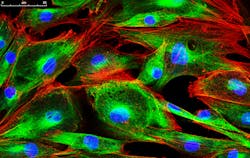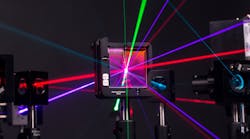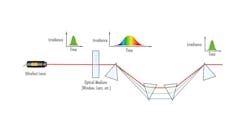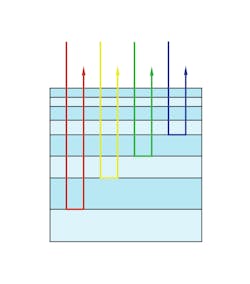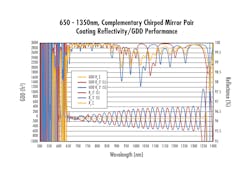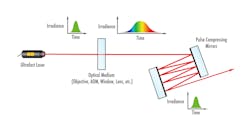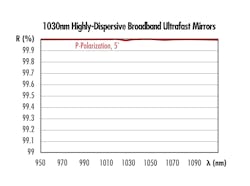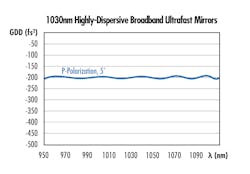Basics of ultrafast lasers: Part 3
Parts one and two of this three-part series focused on the unique features of ultrafast lasers and the basics of selecting the right optical components for an ultrafast laser system. Now, we will dive into how and when to (re)compress ultrafast laser pulses. The short pulse durations of ultrafast lasers naturally have broader bandwidths than conventional laser pulses. The positive dispersion of most optical media causes the ultrafast pulses to then broaden temporarily, reducing system performance. A variety of techniques can be used to mitigate these effects and compress the pulse back to its desired pulse duration, a few of which will be highlighted in this article.
Signs that pulses need to be compressed
Blurry images in ultrafast imaging applications like multiphoton microscopy indicate that pulses may be stretching temporally (see Fig. 1). In ultrafast laser machining, pulse stretching can lead to less-accurate cuts and less precision. It is the short durations and high peak powers of ultrafast pulses that lead to their advantages in both of these applications. Elongating the pulses lowers the probability of multiphoton interactions, which reduces the efficiency of your ultrafast process.
When and how should I compress pulses?
To examine when and how to compress your laser pulse, consider these key questions:
How variable is your system? Can you easily swap in different components to your system? Will you perform different processes or experiments that require different optical configurations? This influences which components are best for your solution.
How sensitive is your process to pulse duration variations? Are pulse durations within a 5 fs accuracy required? Or is 100 fs accuracy sufficient? The less variation allowed, the more flexibility and tunability is required from your pulse compression solution.
What’s your ideal pulse duration, and what’s your starting pulse duration? If you’re working with pulse durations on the order of hundreds of femtoseconds, you can typically use several transmissive optical components before noticing an effect on pulse duration. This is not the case for someone using a significantly shorter pulse, perhaps on the order of 5 to 10 fs. Furthermore, if you start with a 100 fs pulse but want to compress it down to 5 fs, extra steps are involved that are beyond the scope of the pulse compressing strategies discussed in this article.
What other optics are in your beam path? How much group delay dispersion is there? The temporal distortion of the pulse due to dispersion is quantified by group delay dispersion (GDD). GDD is a frequency-dependent value that, for a given material, scales linearly with thickness. Transmissive optical components like windows, lenses, and objectives normally apply positive GDD, so that your once-compressed pulse may emerge from the transmissive optical component with a longer duration than was initially emitted by your laser. Having a rough sense of the magnitude of GDD present in your system can make your selection of pulse recompression strategy quite straightforward.
Pulse compression methods
Prisms/grating compressors. Prisms compress ultrafast pulses by applying a frequency-dependent delay to frequency components of the pulse via the difference in refractive index of the prism material (see Fig. 2). This optical path difference aligns the different wavelengths of the pulse in time. Grating compressors work in a similar way, but rely on diffraction rather than refraction to re-compress the pulse.
Advantages:
- Continuously tunable via variables like distance between elements, amount of material insertion, and groove density.
- Can accommodate very large bandwidths.
- Good for adjusting very, very short pulses.
Disadvantages:
- Difficult for beginners to align.
- Apply higher order dispersion, which can further distort a pulse’s temporal profile.
- Can easily create separate frequency components of the pulse in space (known as “spatial chirp”).
Advantages:
- Broad bandwidths possible.
- Typically have small angles of incidence, which makes it easy to reflect many times between the two mirrors in the chirped mirror pair.
- Easy to align relative to prisms and gratings.
Disadvantages:
- Provides only integral steps of GDD, which are not continuously tunable.
- Need to use in a complementary pair due to GDD oscillations.
- Limited in application by their specified bandwidth.
- Typically feature smaller values of GDD than other methods.
Advantages:
- Able to achieve high magnitudes of GDD.
- Typically feature small angles of incidence for many reflections between multiple mirrors.
- Easy to align compared to prisms and gratings.
- Do not need to use in pairs.
- Typically feature high reflectivity, creating less power loss throughout your optical path.
Disadvantages:
- Provides only integral steps of GDD that are not continuously tunable.
- Limited by their specified bandwidth.
The decision of when and how to recompress ultrafast laser pulses is heavily application-dependent, but a basic knowledge of different methods and their advantages/disadvantages gives you a head start. Discuss your specific application with your optical component supplier for guidance to determine the best pulse-compressing method for your system.
Olivia Wheeler
Olivia Wheeler, Ph.D., is an ultrafast laser optics engineer at Edmund Optics (Barrington, NJ).
